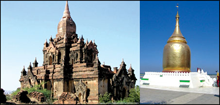
The 12th century painted murals from the Mahavamsa, four abodes of Sinhalese monks and 260 large monuments influenced by Sinhalese were some of the discoveries made by a Sri Lankan team led by scholar Dr. Hema Goonatilake and Sri Lanka Embassy staff including Sri Lankan Ambassador to Myanmar Newton Gunaratne on a recent study visit to the ancient Myanmar city of Bagan.

The 12th century painted murals from the Mahavamsa, four abodes of Sinhalese monks and 260 large monuments influenced by Sinhalese were some of the discoveries made by a Sri Lankan team led by scholar Dr. Hema Goonatilake and Sri Lanka Embassy staff including Sri Lankan Ambassador to Myanmar Newton Gunaratne on a recent study visit to the ancient Myanmar city of Bagan.
Bagan with its roots dating back to the 11th Century was the cradle of Myanmar culture. It is to the Burmese what Anuradhapura is to the Sinhalese,a place of pride and past accomplishments and the soul of the country. Bagan is a huge site with over 4,000 major monuments built over a period of three centuries.
It is said that these monuments are a much greater building feat than the construction for all Europe whose construction had however been spread over nearly seven centuries. The rise of Bagan was closely tied to Sri Lanka connections beginning in the 11th Century through religious and political contacts. The beginning of Bagan intellectual culture was due to the inflow of Buddhist monks from Sri Lanka and the Burmese recorded these in inscriptions and in their literature.
Dr. Hema Goonatilake who had been researching into the Sri Lanka Southeast Asia relations for over two decades had published some of these connections. Dr. Goonatilake guided the embassy group into some not so well known sites in Bagan.
She showed a number of very large Buddhist temple sites which had connections with Sri Lanka. There were numerous stupas built on the Sinhalese bell shaped style-actually there were at least 260 such Sinhalese style stupas. The inflow of Sri Lankan culture was facilitated by Myanmar monks visiting Sri Lanka and Sri Lankan monks visiting Bagan. The stupa enshrining the remains of one of the Myanmar monks Zapata who went to Sri Lanka was there to see it built in the Sri Lanka style. There were four monasteries to house four leading monks from Sri Lanka. The remains of these monasteries are large in number with their own stupa and vihara complexes. The most captivating buildings had murals depicting scenes from the Mahavamsa. One was the Sakyamuni temple which had murals depicting the arrival of Sanghamitta in Sri Lanka, the daughter of Emperor Asoka.
The other was the Gubyaukgyi Temple built in 1113 by Prince Rajakumar, son of King Kyansittha who painted a large number of episodes from the Mahavamsa on the Gubyaukgyi temple walls. These include panels depicting Arahant Mahinda, and King Devanmpiyatissa, the national hero Dutugamunu and his elephant Kandula as well as Prince Gamini sending women’s attire to his father for refusing to fight for the freedom of the country. The invader Elara is depicted in true Mahavamsa style as a just and fair king. His bell of justice is shown together with the calf that wore it - a story known to every child in contemporary Sri Lanka. Sri Lanka’s historical events depicted on the walls end with king Vijayabahu - the contemporary of Rajakumar. The Bagan site is huge and the story of Myanmar connections with Sri Lanka has only been scratched. Much remains to be discovered and researched. Every Sri Lankan who can afford should visit Bagan as much as they visit Buddha Gaya. They will be amazed.
Sri Lanka Embassy
Myanmar
23 August 2009

